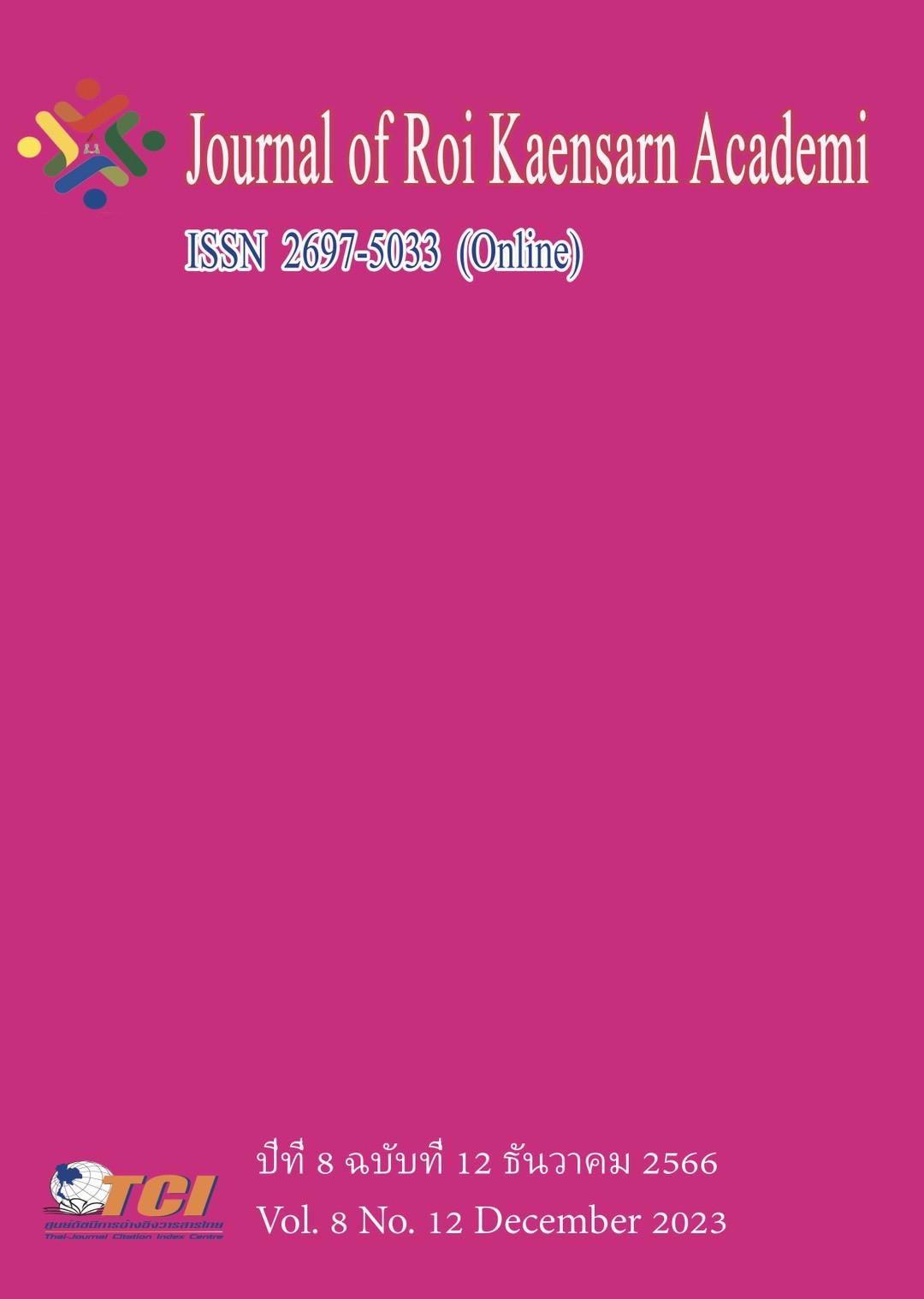ประสิทธิภาพของครูไทยด้านการสอนแบบผสมผสาน จากการเปลี่ยนแปลงในยุคดิจิทัลของโรงเรียนพของครูไทยด้านการสอนแบบผสมผสาน จากการเปลี่ยนแปลงในยุคดิจิทัลของโรงเรียน
Main Article Content
บทคัดย่อ
การวิจัยนี้มีวัตถุประสงค์เพื่อสำรวจและทำความเข้าใจการรับรู้ของครูต่อประสิทธิภาพของการสอนแบบผสมผสาน ซึ่งผสมผสานชั้นเรียนออนไลน์และนอกสถานที่ เปรียบเทียบกับชั้นเรียนในสถานที่แบบตัวต่อตัวในโรงเรียนเอกชนแห่งหนึ่งในเมืองรังสิต จังหวัดปทุมธานี ประเทศไทย เป็นวิจัยเชิงคุณภาพแบบกรณีศึกษาด้วยวิธีการสัมภาษณ์กึ่งโครงสร้างเชิงคุณภาพกับครูจำนวน 6 คน โดยใช้การสุ่มตัวอย่างแบบเจาะจง โดยข้อมูลของงานได้มาจาก 3 แหล่ง คือ การสัมภาษณ์ รวบรวมเอกสาร และการสังเกตการณื โดยข้อมูลการสัมภาษณ์ได้นำมาวิเคราะแบบการวิเคราะห์แก่นสาระ ความน่าเชื่อถือในการวิเคราะห์แก่นสาระได้รับการประเมินผ่านการซักถามร่วมกับนักวิจัยคนอื่นๆ ที่เกี่ยวข้อง ผ่านตรวจสอบกับผู้เชี่ยวชาญด้านการศึกษา และการตรวจสอบกับผู้ให้สัมภาษณ์ การวิจัยนี้จัดทำขึ้นในภาคการศึกษาแรกของปีการศึกษา 2022 ซึ่งเป็นภาคการศึกษาแรกที่เปิดกว้างสำหรับการสอนแบบผสมผสานอย่างเต็มรูปแบบหลังการแพร่ระบาดของไวรัสโควิด-19 โดยในปีการศึกษา 2022 โรงเรียนได้นำกฎระเบียบการสอนแบบผสมผสานมาใช้อย่างเต็มรูปแบบ และกำลังเปลี่ยนโฉมเป็นโรงเรียนดิจิทัล ซึ่งการวิจัยนี้เป็นแนวทางกรณีศึกษาด้วยวิธีการการวิจัยนี้จัดทำขึ้นในภาคการศึกษาแรกของปีการศึกษา 2022
ข้อค้นพบได้นำเสนอได้นำเสนอ 3 ประเด็นหลัก ได้แก่ ความต้องการแรงจูงใจที่ครูท้อแท้จากการสอนแบบผสมผสาน การ การที่โรงเรียนนำระบบเทคโนโลยีสารสนเทศและสื่อสารมาจัดการโครงสร้างพื้นฐานดิจิทัลทั้งซอฟต์แวร์และฮาร์ดแวร์ และการพัฒนาความสามารถ ความรู้และทักษะด้านเทคโนโลยีดิจิทัลของครู ดังนั้นความต้องการแรงจูงใจ การบูรณาการ ICT ในโรงเรียน และการพัฒนาความสามารถด้านดิจิทัลสามารถเพิ่มประสิทธิภาพของครูในการสอนแบบผสมผสานได้
Article Details
เอกสารอ้างอิง
Al-Senaidi, S., Lin, L., & Poirot, J. (2009). Barriers to adopting technology for teaching and learning in Oman. Computers & education, 53(3), 575-590.
Barba-Sánchez, V., Martínez-Ruiz, M. D. P., & Jiménez-Zarco, A. I. (2007). Drivers, benefits and challenges of ICT adoption by small and medium sized enterprises (SMEs): a literature review. Problems and Perspectives in Management, 5(1), 103-114.
Bernard, H. R. (2017). Research methods in anthropology: Qualitative and quantitative approaches. Rowman & Littlefield.
Bogdan, R., & Biklen, S. K. (1997). Qualitative research for education. Boston, MA: Allyn & Bacon.
Bonk, C. J., & Graham, C. R. (2012). The handbook of blended learning: Global perspectives, local designs. John Wiley & Sons.
Bowen, G. A. (2009). Document analysis as a qualitative research method. Qualitative research journal, 9(2), 27-40.
Bryan, & Volchenkova. (2016). Blended Learning: Definition, Models, Implications for Higher Education. Bulletin of the South Ural State University Series “Education. Education Sciences,”8(2), 24–30. https://doi.org/10.14529/ped160204
Creswell, J. W., & Creswell, J. D. (2017). Research design: Qualitative, quantitative, and mixed methods approaches. Sage publications.
Gallagher, M. S. (2018). KakaoTalk meets the ministry of education: mobile learning in South Korean higher education. In Mobile learning and higher education (pp. 136-147). Routledge.
Glesne, C. (2016). Becoming qualitative researchers: An introduction. Pearson. One Lake Street, Upper Saddle River, New Jersey 07458.
Gonzalez, T., de la Rubia, M. A., Hincz, K. P., Comas-Lopez, M., Subirats, L., Fort, S. & Sacha, G. M. (2020). Influence of COVID-19 confinement on students’ performance in higher education. PLoS ONE, 15(10), article e0239490. https://doi.org/10.1371/ journal.pone.0239490
Guest, G., Bunce, A., & Johnson, L. (2006). How many interviews are enough? An experiment with data saturation and variability. Field methods, 18(1), 59-82.
Jung, I. (2005). ICT-pedagogy integration in teacher training: Application cases worldwide. Journal of Educational Technology & Society, 8(2), 94-101.
Ilomaki, L., Paavola, S., Lakkala, M., & Kantosalo, A. (2016). Digital competence–an emergent boundary concept for policy and educational research. Education and information technologies, 21(3), 655-679.
Kirschner, P., Wubbels, T., & Brekelmans, M. (2008). Benchmarks for teacher education programs in the pedagogical use of ICT. In International handbook of information technology in primary and secondary education(pp. 435-447). Springer, Boston, MA.
Krysik, J. L. (2013). Research for effective social work practice. Routledge.
Lincoln, Y. S., & Guba, E. G. (1985). Naturalistic inquiry. sage.
Lindner, J. R. (1998). Understanding employee motivation. Journal of extension, 36(3), 1-8.
Luthans, K. (2000). Recognition: A powerful, but often overlooked, leadership tool to improve employee performance. Journal of Leadership Studies, 7(1), 31-39.
Markauskaite, L. (2007). Exploring the structure of trainee teachers’ ICT literacy: the main components of, and relationships between, general cognitive and technical capabilities. Educational Technology Research and Development, 55(6), 547-572.
Meleisea, E. L. L. I. E. (2007). The UNESCO ICT in education programme. Bangkok, Thailand: United Nations Educational, Scientific and Cultural Organization.
Michos, K., & Hernández-Leo, D. (2020). CIDA: A collective inquiry framework to study and support teachers as designers in technological environments. Computers & Education, 143, 103679.
Nabi-Ranjbari, M., Heidari Tabrizi, H., & Afghari, A. (2020). Evaluation of the Latest Pre-Service Teacher Education Curriculum in EFL Context: A Testimony of Teachers, Teachers Educators and Student Teachers' Perspectives. Applied Research on English Language, 9(1), 1-24.
Nashir, M., & Laili, R. N. (2021). Hybrid Learning as an Effective Learning Solution on Intensive English Program in the New Normal Era. IDEAS: Journal on English Language Teaching and Learning, Linguistics and Literature, 9(2), 220232.
Nganji, J. T. (2018). Towards learner-constructed e-learning environments for effective personal learning experiences. Behaviour & Information Technology, 37(7), 647-657.
Pozos Pérez, K. V., & Tejada Fernández, J. (2018). Competencias digitales en docentes de educación superior: niveles de dominio y necesidades formativas. Revista Digital de Investigación en Docencia Universitaria, 12(2), 59-87.
Reichstein, C. (2019). Strategic IT management: how companies can benefit from an increasing IT influence. Journal of enterprise information management.
Spall, S. (1998). Peer debriefing in qualitative research: Emerging operational models. Qualitative inquiry, 4(2), 280-292.
Tracy, S. J. (2010). Qualitative quality: Eight “big-tent” criteria for excellent qualitative research. Qualitative inquiry, 16(10), 837-851.
Tuffaha, M. (2020). The determinants of employee’s performance: A literature review. Journal of Economics and Management Sciences, 3(3), p14-p14.
Walters, M. (1995). Performance management Handbook/Institute of personnel and development. London.–1995. Рисунок А.
Whitley, R. (2002). Competing capitalisms: Institutions and economies. Edward Elgar Publishing.
Zhang, J. (2022). Research on Mixed Classroom Application Effect under Information Technology-Take Jining Normal University as an Example. Advances in Educational Technology and Psychology, 6(8), 62-67.

